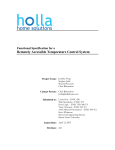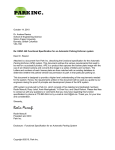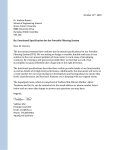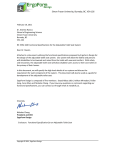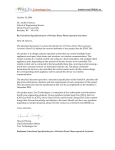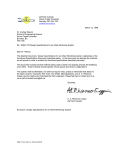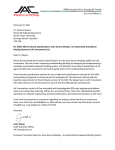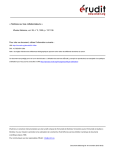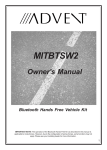Download Tactile Vision Glove for the Blind
Transcript
School of Engineering Science Simon Fraser University Burnaby, BC V5A 1S6 http://www.S3Tech.tk [email protected] October 18, 2004 Dr. Andrew Rawicz School of Engineering Science Simon Fraser University Burnaby, British Columbia V5A 1S6 Re: ENSC 340 Functional Specification for a Tactile Vision Glove for The Blind Dear Dr. Rawicz: The attached document, Functional Specification for a Tactile Vision Glove for The Blind, outlines our project for ENSC 340 (Special Project Course). We are in the process of designing and implementing a glove that would inform a visually impaired person, via tactile feedback, of the existence and shape of the nearby obstacles. With the help of our product, the blind person can find his desire path and identify unknown objects. This functional specification provides details of all the parameters and requirements for operation of our device. Included in this document is the list of complete specifications for the prototype to be delivered by mid-December, 2004, as well as the partial set of requirements for future production-quality versions. S3 Technologies consists of three motivated, enthusiastic, had working and talented fourth-year engineering students: Shaun Marlatt (CEO), Sina Afrooze (COO) and Mahmoud-Sam Zahed (CFO). Should you have any questions or concerns, please do not hesitate to contact us at [email protected]. Sincerely, Shaun Marlatt Shaun Marlatt President and CEO S3 Technologies Enclosure: Functional Specification for a Tactile Vision Glove for the Blind Functional Specification for Tactile Vision Glove for the Blind S3 Technologies: Shaun Marlatt Sina Afrooze Mahmoud-Sam Zahed Contact Person: Shaun Marlatt [email protected] Submitted to: Dr. Andrew Rawicz – ENSC 340 Scott Logie – ENSC 340 Mike Sjoerdsma – ENSC 305 School of Engineering Science Simon Fraser University Issue Date: October 18, 2004 Revision: 1.0 Functional Specification for a Tactile Vision Glove for The Blind October 18, 2004 [email protected] Executive Summary Increasing number of visually impaired all around the world has encouraged many engineers to take advantage of advances in the integrated circuit technology and engineering materials to develop certain devices that meet special needs of this large group of people. Tactile Vision Glove is one of the devices that will use recent microelectronics technology to increase mobility and independence of those who are visually impaired. This device enables the user to detect the objects around by providing distance and shape information through tactile feedback. The development of the Tactile Vision Glove will occur in two phases. Phase 1 is the development of the proof of concept device and phase 2 is the development of the production prototype. After completion of the first phase, the Tactile Feedback Glove will: 1. detect objects and give tactile feedback through vibration 2. work consistent for several environmental conditions 3. have certain user interfaces and several modes After completion of the second phase, the device will also: 1. work consistent under ambient effects and different weather conditions 2. have battery life indication and special low battery reaction 3. have extra safety and reliability 4. be available in different sizes and materials The first phase of development of the Tactile Vision Glove will be completed by mid December, 2004. i Copyright © 2004, S3 Technologies Functional Specification for a Tactile Vision Glove for The Blind October 18, 2004 [email protected] Table of Contents 1 2 3 4 5 6 Introduction................................................................................................................. 1 1.1 Scope................................................................................................................... 1 1.2 Intended Audience .............................................................................................. 1 1.3 Objective ............................................................................................................. 2 System Requirements.................................................................................................. 3 2.1 System Overview ................................................................................................ 3 2.2 Physical Requirements........................................................................................ 4 2.2.1 Physical Appearance................................................................................... 4 2.2.2 Material and Optics..................................................................................... 4 2.2.3 Electronics................................................................................................... 4 2.3 Operation Requirements ..................................................................................... 5 2.3.1 Ambient Effects .......................................................................................... 5 2.3.2 Environmental Effects ................................................................................ 5 2.4 Power .................................................................................................................. 5 2.5 Detection ............................................................................................................. 6 2.6 Haptics ................................................................................................................ 6 2.7 Fault Handling .................................................................................................... 6 Usability Requirements............................................................................................... 7 3.1 Modes of Operation ............................................................................................ 7 3.1.1 Absolute mode ............................................................................................ 7 3.1.2 Differential mode ........................................................................................ 7 3.1.3 Normal and Reduced Intensity modes ........................................................ 7 3.1.4 Reduced power mode.................................................................................. 8 3.2 Interface .............................................................................................................. 8 3.3 Safety and Reliability.......................................................................................... 9 Documentation and User Training............................................................................ 10 Regulatory Compliance ............................................................................................ 11 Conclusion ................................................................................................................ 12 ii Copyright © 2004, S3 Technologies Functional Specification for a Tactile Vision Glove for The Blind October 18, 2004 [email protected] List of Figures and Tables Figure 2.1. A conceptual structure of the Tactile Vision Glove ......................................... 3 iii Copyright © 2004, S3 Technologies Functional Specification for a Tactile Vision Glove for The Blind October 18, 2004 [email protected] 1 Introduction The Tactile Vision Glove is an assistant device for the blind that enables them to virtually ‘see’ distant objects through tactile feedback. The glove helps the blind person to determine the make-up of their relative surroundings, by measuring the distance to nearby objects, then conveying their approximate shape to the blind person through tactile feedback. Using the Tactile Vision Glove, a blind person will be able not only to locate the objects and obstacles and their distance from him/her, but also to sense the rough shape of the object, as if they were actually touching it. Our project will be developed in a series of stages, beginning with a proof of concept design to be delivered by mid December, 2004. If the proof of concept design proves successful in user tests, work would begin on a production prototype with greater functionality. 1.1 Scope This document describes the functional requirements that must be met by a functioning Tactile Vision Glove. Both the proof of concept functional requirements and production prototype requirements are detailed in this document. Many of the functional requirements are reserved for the production prototype only, since the market will demand more substantial improvements in terms of price and quality. Moreover, we except to gain extensive experience throughout the development of the first version and improve the proposed design accordingly. As a result, although extensive, only a partial set of requirements have been specified for the production version. 1.2 Intended Audience Design engineers will use this document to design and assemble components of the Tactile Vision Glove. Marketing managers will use this document to promote the product in the market and inform blind people of the convenience they can obtain using the Tactile Vision Glove. Project managers and quality engineers will use this document to ensure that the progress is towards the development objectives and verify that the final product has met the desired specifications. 1 Copyright © 2004, S3 Technologies Functional Specification for a Tactile Vision Glove for The Blind October 18, 2004 [email protected] 1.3 Objective This document will use the following convention to denote requirements: R[#] A functional requirement To distinguish between the requirements for each stage of the product development, the following convention will be used: (1) Applicable to all iterations (2) Applicable to the proof of concept device only (3) Applicable to the production device only 2 Copyright © 2004, S3 Technologies Functional Specification for a Tactile Vision Glove for The Blind October 18, 2004 [email protected] 2 System Requirements 2.1 System Overview The Tactile Vision Glove, as the name indicates, is a glove that has several distance sensors and vibrators mounted on it. The sensors are oriented so that when the glove is worn by blind person, with the hand held in a palm facing forward configuration, the sense of distance between the glove and the target object is accurately conveyed. Figure 2.1 illustrates a conceptual Tactile Vision Glove, where the sensors and vibrators are located and how the device is operated. Feedback through the glove about the distance of objects is conveyed through the intensity and frequency of the vibration. The amount of vibration of each of the vibrators is proportional to the distance measured by the sensors in the palm of the hand, with more vibration conveying closer distance. Through the use of multiple distance sensors and vibrating transducers, the blind person is able to feel the rough shape of the object or obstacles without actually touching them. Some Unknown Object Infrared distance measurement User Interface on glove Sensors and Vibrators at palm of the hand Figure 2.1. A conceptual structure of the Tactile Vision Glove 3 Copyright © 2004, S3 Technologies Functional Specification for a Tactile Vision Glove for The Blind October 18, 2004 [email protected] 2.2 Physical Requirements Because the Tactile Vision Glove is intended to be worn on hand, its physical requirements shall be specified to achieve comfort and ease-of-use for the blind person using the device. 2.2.1 Physical Appearance R[1] The glove should differ in appearance from the common gloves used by public to inform others that the user is blind. (3) R[2] The glove must be available in three sizes, small, medium and large. (3) R[3] Finger tips of the glove should be uncovered such that the person can feel objects. (3) R[4] The battery must be pocket size and attachable to a belt. (3) R[5] The connection to battery must be hidden through the user’s cloths and the connecting wire shall be long enough to prevent restriction of movement. (3) R[6] The glove and electronics should be detachable so that the glove may be washed, replaced, or interchanged. (1) R[7] The glove should be light weight so that it does not tire the wearer’s arm. (1) 2.2.2 Material and Optics R[8] The glove must be made from a material that does not cause adverse skin reactions and is durable. (3) R[9] The glove should be available in two different materials for different seasonal weather conditions. (3) R[10] The glove must be made out of water-proof material. (3) R[11] Optical emissions (Infrared) from the device must be low power and must not cause damage to the retina if exposed. (1) 2.2.3 Electronics R[12] Electronics must be isolated from person’s skin. (1) R[13] Electronics must be water-proofed. (3) R[14] The prototype design should be modular so that interchange of electrical components can be done without difficulty. (2) 4 Copyright © 2004, S3 Technologies Functional Specification for a Tactile Vision Glove for The Blind October 18, 2004 [email protected] R[15] Electronics should be separated from the battery through a power cable. (1) R[16] The audible noise emitted by the glove should be less than 40 dB1. (1) 2.3 Operation Requirements Because the Tactile Vision Glove will be used in variety of situations, there must be certain stability criteria met by the device. 2.3.1 Ambient Effects R[17] The device must operate consistent in a wide temperature range from about -20 degrees Celsius to about 40 degrees Celsius. (3) R[18] The device must operate consistent in wide humidity range from 0 % to 100 % (3) 2.3.2 Environmental Effects R[19] The device should operate consistently in different weather conditions, such as rain, snow or sun. (1) R[20] The device should not be very sensitive to normal foggy or dusty air and should detect objects to no less that 100 cm under these conditions. (1) R[21] Electronics should not be sensitive to normal electromagnetic interference. (1) R[22] The device should operate consistently in different lighting conditions such as indoor light and sunlight. (1) R[23] The device should give consistent readings regardless of the color or reflectivity of the detected object. (1) 2.4 Power Because in the operation of Tactile Vision Glove, connection to the power outlet is not possible, electrical energy of the system must be supplied by a battery. Because battery life is limited, there are certain requirements that must be met for the device to be usable. R[24] The battery life must be enough for a day trip (at least 10 hours). (3) R[25] The device should have a battery life indication through vibration feedback, i.e. the user can test the battery life at any time and get vibration feedback proportional to the remaining battery life. (3) 1 40 dB is the noise level in a quiet room, normalized to 0dB, the threshold of human hearing. 5 Copyright © 2004, S3 Technologies Functional Specification for a Tactile Vision Glove for The Blind October 18, 2004 [email protected] R[26] The device should have an alarm indicating that battery will be empty within an hour if operated normally. (3) R[27] The battery should be accompanied with a charger so that the cost of changing the battery is prevented. (3) R[28] The charger should be compatible with 220V and 110V standards. (3) R[29] The package should include a spare battery so that the user can run the glove while the empty battery is being charged. (3) 2.5 Detection The Tactile Vision Glove must meet certain accuracy and resolution in order to be useful in detecting objects (both their distance and shape). R[30] The device must be able to detect objects in 4cm to 150cm range. (1) R[31] The prototype device must be able to detect a 5cm gap or rise (curb edge) from 20cm distance and a 10cm gap from 100cm distance. (2) R[32] The production device must be able to detect a 5cm gap or rise from 150cm distance. (3) 2.6 Haptics The tactile feedback of the system must meet certain criteria in order to provide useable information to the user. R[33] The vibration frequency must be below 200Hz, in the low frequency hearing range. (1) R[34] The user must be able to set the maximum vibration intensity of the device. (1) R[35] The response time between measurement and rendering by the vibrating transducers should be on the order of 100ms. (1) 2.7 Fault Handling R[36] The glove should provide audible feedback to indicate faulty operations, where the tactile hardware has failed or no longer has sufficient power to run. (1) 6 Copyright © 2004, S3 Technologies Functional Specification for a Tactile Vision Glove for The Blind October 18, 2004 [email protected] 3 Usability Requirements Usability is an important criterion for any device built for human. In order to make the Tactile Vision Glove a user friendly device, certain requirements for operation, interface, and safety must be met. 3.1 Modes of Operation The state of the Tactile Vision Glove can be changed through changing different modes that are available to the user. R[37] The device must have two operation modes: Differential and Absolute. (1) R[38] The device must have two vibration modes: Normal and Reduced Intensity. (1) 3.1.1 Absolute mode R[39] In the absolute mode of operation, the device should map the distance measured by each sensor to some specified vibration intensity, maximum vibration for about 4cm and no vibration for greater than 150cm. (1) 3.1.2 Differential mode R[40] In the differential mode of operation, the device must dynamically take the time average of the average distance measured by sensors in a short time interval (approximately 5sec). R[41] In the differential mode of operation, there must be no vibration feedback to the user as long as all distances measured by sensors are equal to the time averaged value.(1) R[42] In the differential mode of operation, there must be vibration feedback if the distance measured by any of the sensors is not equal to the time averaged value. In this case, the amount if vibration for each vibrator depends on the difference between distances detected by individual sensors.(1) 3.1.3 Normal and Reduced Intensity modes R[43] In Normal Intensity mode, the vibration range should be from 0dB to maximum vibration setting. (1) R[44] In Reduced Intensity vibration mode, the vibration range should be from 0dB to a factor of the maximum vibration setting (e.g. one half of maximum vibration setting). (1) 7 Copyright © 2004, S3 Technologies Functional Specification for a Tactile Vision Glove for The Blind October 18, 2004 [email protected] 3.1.4 Reduced power mode R[45] The device enters a reduced power mode when the battery remaining is less than one hour in normal mode. (3) R[46] The reduced power mode should extend the remaining battery life by a minimum of three times. (3) R[47] In reduced power mode, if the operation mode is absolute, it should be switched to differential mode for lower power consumption. (1) R[48] In reduced power mode, the user can enforce the device to operate in absolute mode if needed. (1) R[49] In reduced power mode, the device enters the Reduced Intensity vibration mode. (1) R[50] In reduced power mode, the user can enforce the device back to Normal Intensity vibration mode if needed. (1) 3.2 Interface Interface of the Tactile Vision Glove is an important part of the device, because the only way that the user can interact with the device and customize it for certain needs is through its interface. R[51] The device should provide audible cues for error or warning states. (1) R[52] Controls on the glove should be clearly labeled in brail, or have clearly distinguishable shapes. (3) R[53] Controls should be located on the glove electronics in easily reachable positions. (1) R[54] The user controls should provide the ability to toggle between absolute and differential mode. (1) R[55] The user controls should provide the ability to toggle between reduced power mode and normal mode. (1) R[56] The user controls should provide the ability to toggle between reduced vibration intensity and normal vibration intensity modes. (1) R[57] The user controls should provide the ability to turn the glove power on or off. (1) R[58] The user controls should provide the ability to adjust the maximum intensity of the tactile feedback. (1) 8 Copyright © 2004, S3 Technologies Functional Specification for a Tactile Vision Glove for The Blind October 18, 2004 [email protected] 3.3 Safety and Reliability Safety of the user must be guaranteed when using the Tactile Vision Glove. Certain requirements must be considered to make sure that the device will not cause any safety issues and will work reliably. R[59] In the event of a short circuit of the electronics the device will shut off. (3) R[60] Accidental shutoff of the device should be prevented through design and placement of the on-off button. (3) R[61] The power cable connecting the glove electronics should include a locking mechanism to prevent accidental disconnection during use. (3) R[62] The power cable connecting the battery and glove should be easy for a blind person to attach with a single hand. (3) R[63] The glove should be easy to put on. (1) 9 Copyright © 2004, S3 Technologies Functional Specification for a Tactile Vision Glove for The Blind October 18, 2004 [email protected] 4 Documentation and User Training Because the users of Tactile Vision Glove are blind people, we need to provide them with customized documentation. The documentation for our product would be in both oral and Braille format. R[64] The product must include a printed manual in Braille format as well as a recorded manual in tape and/or CD in all languages applicable to the country of sale. (3) R[65] The manuals must include all features in product and examples illustrating their use. (1) R[66] The taped manual should be accompanied with a printed document so that it can be read for the blind person. (3) R[67] The tape and document should also contain contact information on how to reach S3 Technologies. (3) R[68] Training must be provided by people with experience in dealing with the blind individuals. (3) R[69] The user manual must include complete instructions and explanations on how the glove would operate and what the responses would be in different situations. (1) R[70] The manuals should also include a troubleshooting section to allow the user to get around minor difficulties. (1) R[71] Minimal user training should be necessary to use the device. (1) R[72] Training of the final production device must be provided entirely by the user manuals. (3) R[73] Users of the proof of concept device must be instructed or supervised by the project developers.(2) 10 Copyright © 2004, S3 Technologies Functional Specification for a Tactile Vision Glove for The Blind October 18, 2004 [email protected] 5 Regulatory Compliance The Tactile Vision Glove would be in direct contact with human body and also it is to guide the blind person on his way. Consequently it should conform to a number of general safety and government regulations. R[74] The glove will comply with CE regulations, so that it may be exported to countries of the European Union. (3) R[75] The glove will comply with CCC regulations, so that it may be exported to China. R[76] The glove should comply with all safety regulations pertaining to safety and assistive devices for blind people. R[77] The device will conform to FCC regulations on the interference of electronic devices. R[78] The glove must be smooth and the mounted components should have symmetric edges and corners. All electrical connections will be enclosed to avoid any danger to the user. (1) R[79] The charger for the battery should be CSA and CE certified to avoid possible danger when being plugged to the wall. (3) R[80] Optics used in the device must comply with CSA, CE, UL and FCC regulations. (3) 11 Copyright © 2004, S3 Technologies Functional Specification for a Tactile Vision Glove for The Blind October 18, 2004 [email protected] 6 Conclusion The requirements specified in this document describe the Tactile Vision Glove exclusively. The requirements labeled as (1) or (2) will be incorporated in our proof of concept design, to be completed by mid December, 2004. Requirements proceeded by (3) are the additional features that will be included to market our final product. Moreover, any improvement encountered during our design process to make a successful product on the market would be also taken into account. 12 Copyright © 2004, S3 Technologies

















